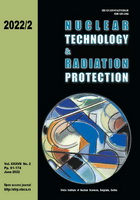
STUDY ON KINETIC PARAMETERS CHARACTERISTICS OF PEBBLE BED REACTOR USING HTR-PROTEUS FACILITY
Pages: 119-127
Authors: Zuhair, Wahid Luthfi, Sriyono, Suwoto, and Topan SetiadipuraAbstract
The inherent safety feature of a pebble-bed reactor can be observed from its kinetic parameters. Proper modeling for calculating the reactor kinetic is also a concern for safe operation during normal and transient conditions. This study is intended to investigate the kinetic parameters characteristics of a pebble bed reactor using HTR-Proteus. A series of calculations were conducted using MCNP6 code and ENDF/B-VII library. The calculation results show that the negative value on core temperature reactivity is affected dominantly by the Doppler broadening effect. Prompt neutron lifetime l and mean generation time ? are slightly changed due to an increase in fuel temperature, moderator, and reflector that changed the neutron moderation and absorption over this part of the reactor. For (Th, U)O2, UO2, and PuO2 cores, the effective delayed neutron fraction βeff values are more influenced by 233U, 235U, and 239Pu, respectively. In terms of stability during reactivity insertion, the UO2 core is more stable and easier to control because its βeff value is the largest compared to (Th, U)O2 and PuO2 cores. It can be concluded that changing temperature must be controlled because it does not only affect the reactivity but also kinetic parameters as part of developing inherent safety features on the pebble-bed reactor.
Key words: kinetic parameter, pebble bed reactor, HTR-proteus, MCNP6, ENDF/B-VII
FULL PAPER IN PDF FORMAT (978 KB)
